Slides (pdf)[6.3MB] - Graphics Hardware
Slides (pdf)[6.3MB] - Graphics Hardware
Slides (pdf)[6.3MB] - Graphics Hardware
Create successful ePaper yourself
Turn your PDF publications into a flip-book with our unique Google optimized e-Paper software.
<strong>Graphics</strong> Everywhere –<br />
Pixels in your Pocket<br />
Kari Pulli<br />
Research Fellow<br />
Nokia Research Center<br />
1 © NOKIA N-Gage presentation.ppt
2 © NOKIA <strong>Graphics</strong><strong>Hardware</strong>.ppt<br />
Outline<br />
• History of 3D on Nokia / GSM<br />
• Key enablers and challenges for mobile 3D<br />
• Mobile 3D APIs<br />
• Current Mobile HW offering<br />
• Use cases for mobile 3D graphics<br />
• Mobile gaming<br />
• What’s important in mobile 3D graphics<br />
• The way forward
• What’s the world’s most played<br />
electronic game?<br />
• According to The Guardian (May 2001)<br />
3 © NOKIA <strong>Graphics</strong><strong>Hardware</strong>.ppt<br />
GSM world: State-of-the-art in 2001<br />
“it took Nintendo 10 years to sell 100m Game<br />
Boys whereas Nokia sold 128m handsets last<br />
year alone”<br />
• Communicator demo<br />
• Assembly 2001<br />
• Remake of 1994 winning Amiga demo<br />
• ~10 year difference from PC to mobile<br />
• Began SW 3D engine at Nokia
• The fruits of the labor in 2002<br />
4 © NOKIA <strong>Graphics</strong><strong>Hardware</strong>.ppt<br />
GSM world: State-of-the-art in 2002<br />
• A SW engine implementing a subset of OpenGL<br />
• 3410 shipped in May 2002<br />
• The applications were<br />
• Downloadable 3D screensavers (artist created content)<br />
• FlyText screensaver (end-user created content)<br />
• a 3D game
• N-Gage ships<br />
• Lots of proprietary 3D engines on<br />
various Series 60 phones<br />
• Starting already in late 2002<br />
5 © NOKIA <strong>Graphics</strong><strong>Hardware</strong>.ppt<br />
Top-of-the-line 3D on GSM in 2003<br />
Fathammer’s<br />
Geopod<br />
on XForge
• N-Gage QD<br />
• Better input keys<br />
• Hot-swap of MMC cards<br />
• 6630 will ship in late 2004<br />
• OpenGL ES 1.0 (for C++)<br />
• M3G (aka JSR-184, for Java)<br />
6 © NOKIA <strong>Graphics</strong><strong>Hardware</strong>.ppt<br />
Top-of-the-line 3D on GSM in 2004
7 © NOKIA <strong>Graphics</strong><strong>Hardware</strong>.ppt<br />
Key enablers and<br />
challenges
• Recent improvements<br />
• Resolution<br />
8 © NOKIA <strong>Graphics</strong><strong>Hardware</strong>.ppt<br />
• S60: 176 x 208<br />
• S80: 640 x 200<br />
• S90: 640 x 320<br />
• Color depth<br />
• Not many new B/W phones<br />
• 12 bit RGB, 16 bit RGB, …<br />
• Physical size remains limited<br />
• Near-eye micro displays in the future?<br />
What has changed? Displays!
• 3410<br />
• ARM 7 @ 26MHz<br />
• Not much caching, narrow bus<br />
• 7650<br />
• ARM 9 @ ~100MHz<br />
• Decent caching, better bus<br />
• 6630<br />
• ARM 9 @ ~200MHz<br />
• Faster memories<br />
• Still no FPUs though<br />
9 © NOKIA <strong>Graphics</strong><strong>Hardware</strong>.ppt<br />
What has changed? Computation!<br />
• To high-end soon (at least for graphics), mid-tier later,<br />
low-end remains integer longer
10 © NOKIA <strong>Graphics</strong><strong>Hardware</strong>.ppt<br />
Remains a challenge? Power!<br />
• Battery improvement doesn’t follow Moore’s law<br />
• Only 5-10% per year<br />
• Gene’s law<br />
• "power consumption of integrated circuits decreases exponentially"<br />
over time and because of that the whole system built around chips<br />
will get smaller, and batteries will last longer<br />
• Since 1994, the power required to run an IC has declined 10x every<br />
two years<br />
• But the performance of two years ago is not enough<br />
• Pump up the speed<br />
• Use up the power savings
• But ridiculously good batteries<br />
still won’t be the miracle cure<br />
• The devices are small<br />
• Generated power must get out<br />
• No room for fans<br />
• Thermal management must be<br />
considered early in the design<br />
• Hot spot would fry electronics<br />
11 © NOKIA <strong>Graphics</strong><strong>Hardware</strong>.ppt<br />
• Or at least inconvenience the user…<br />
• The heat must be conducted through<br />
the case walls, and finally removed to<br />
the ambient<br />
Remains a challenge? Thermal mgt!<br />
www.coolingzone.com
12 © NOKIA <strong>Graphics</strong><strong>Hardware</strong>.ppt<br />
New standard APIs<br />
for mobile 3D
• OpenGL ES and M3G<br />
13 © NOKIA <strong>Graphics</strong><strong>Hardware</strong>.ppt<br />
Layered model --- reuse of resources<br />
• Designed concurrently (and partly by the same people)<br />
• Influenced each other<br />
• Layered implementation model (immediate benefit of same HW)
14 © NOKIA <strong>Graphics</strong><strong>Hardware</strong>.ppt<br />
OpenGL ES<br />
• Forum: Khronos group<br />
• OpenGL ES 1.0 design targets<br />
• Compactness: Eliminate un-needed functionality<br />
• Redundant, expensive, unused<br />
• Footprint target 50KB<br />
• Target both SW and HW implementations<br />
• don’t mandate FPU support<br />
• Retain good things of OpenGL<br />
• Basic architecture<br />
• Extensibility<br />
• Conformance tests
15 © NOKIA <strong>Graphics</strong><strong>Hardware</strong>.ppt<br />
OpenGL ES 1.0 in a nutshell<br />
• Retain functionality that apps can’t emulate<br />
• Full fragment processing of OpenGL 1.3<br />
• Corollary: drop convenience functionality<br />
• GLU, evaluators, feedback mode, selection, display lists<br />
• Stippling, polygons / quads, drawpixels, bitmap: all can be emulated<br />
• Texcoords, user clipping, can be calculated in the application<br />
• Simplify state machine<br />
• Drop glBegin – glEnd, use arrays instead<br />
• Only RGBA (no indices), only double-buffering, draw only to back buffer<br />
• Queries<br />
• Apps can keep track of their own state<br />
• Only static ones
• OpenGL ES Common<br />
• Doubles => floats<br />
16 © NOKIA <strong>Graphics</strong><strong>Hardware</strong>.ppt<br />
Profiles<br />
• Also support fixed point input (signed 16.16)<br />
• Require OpenGL (~ float) accuracy with matrix calculations<br />
• OpenGL ES Common Lite<br />
• Drop floats altogether<br />
• Only fixed (and integers, of course)<br />
• Only require 16.16 fixed point accuracy with matrices, allow overflows<br />
• OpenGL ES Safety Critical<br />
• For aviation, cars, etc. --- anywhere where certification required<br />
• Still under work
17 © NOKIA <strong>Graphics</strong><strong>Hardware</strong>.ppt<br />
OpenGL matrices without FPUs OK!<br />
• What makes the emulation of IEEE fp slow?<br />
• Special cases (such as NaN, Inf, …) take a lot of processing<br />
• After every operation you have to do book-keeping<br />
• Renormalize, i.e., shift the mantissa and update exponent accordingly<br />
• If you know context you can make shortcuts<br />
• Matrix times vector: lots of structure ( (4x4, 4x1) => 64 muls, 48 adds)<br />
• Lets also assume vertices are ints for fixed, matrix elements floats<br />
• First do the maths on mantissas (effectively integer arithmetics)<br />
• Then do the book-keeping of exponents at the end<br />
• Easily 10x speed win compared to emulated IEEE fp<br />
• Only a modest speed loss w.r.t fixed point-only implementation<br />
• Floats multiplied with other floats more difficult and slower…
• More HW oriented than 1.0<br />
18 © NOKIA <strong>Graphics</strong><strong>Hardware</strong>.ppt<br />
OpenGL ES 1.1 --- for SIGGRAPH 2004<br />
• Buffer Objects --- allow caching vertex data<br />
• Draw Texture --- pixel rectangles using tex units (data can be cached)<br />
• Better Textures --- >= 2 tex units, combine (+,-,interp), dot3 bumps<br />
• Matrix Palette --- vertex skinning (>= 3 M / vtx, palette >= 9)<br />
• User Clip Planes --- portal culling (>= 1)<br />
• Point Sprites --- particles as points not quads, attenuate size w/ distance<br />
• State Queries --- enables state save / restore, good for middleware
• Address programmability<br />
• Assume vertex and pixel shaders<br />
• GL Shading language<br />
• Work just starting, but possibly<br />
19 © NOKIA <strong>Graphics</strong><strong>Hardware</strong>.ppt<br />
OpenGL ES 2.0 for SIGGRAPH 2005?<br />
• Really stripped-down version of OpenGL 2.0<br />
• no fixed functionality<br />
• No backwards compatibility<br />
• Should the shader compiler be on the device?<br />
• Mobile 3D feature set is catching up desktop fast!
20 © NOKIA <strong>Graphics</strong><strong>Hardware</strong>.ppt<br />
What about Java?<br />
• On desktop new hotspot compilers are pretty good<br />
• but on mobiles there’s a clear difference between C and Java performance
21 © NOKIA <strong>Graphics</strong><strong>Hardware</strong>.ppt<br />
Need for a higher abstraction level<br />
• A game is much more than just 3D rendering<br />
• Objects, properties, relations (scene graph)<br />
• Keyframe and other animations<br />
• Etc. (game logic, sounds, …)<br />
• If everything else but rendering is in Java<br />
• A very large percentage of the processing is in slow Java<br />
• Even if rendering was 100% in HW, total acceleration remains limited<br />
• A higher level API could help<br />
• More of the functionality could be implemented in native (=faster) code<br />
• Only the game logic must remain in Java
22 © NOKIA <strong>Graphics</strong><strong>Hardware</strong>.ppt<br />
Java3D ES?<br />
• Java3D seemed to be a good starting point<br />
• But “Java3D ES” didn’t work out<br />
• Java3D was really designed for large-resource systems<br />
• Java3D distribution is ~40MB (~300x too big for us)<br />
• Didn’t really fit together with MIDP, a large redesign necessary<br />
• M3G (JSR-184), a new API<br />
• Nodes and scene graph<br />
• Extensive animation support<br />
• Binary file format and loader
• The tree encodes structure<br />
23 © NOKIA <strong>Graphics</strong><strong>Hardware</strong>.ppt<br />
Scene graphs are made of nodes<br />
• the actual data (vertices, textures, animation data, …) can be shared<br />
• Nodes encode relative transformations<br />
and inherited alpha<br />
• World is the root<br />
• a special case of a group<br />
• Other nodes<br />
• camera<br />
• light<br />
• mesh<br />
• sprite<br />
World<br />
Group Camera SkinnedMesh Light<br />
Mesh MorphingMesh<br />
Group<br />
Group<br />
Group Mesh<br />
Sprite
• SkinnedMesh for<br />
articulated motions<br />
• Bones have weighted<br />
associations to vertices<br />
24 © NOKIA <strong>Graphics</strong><strong>Hardware</strong>.ppt<br />
Special meshes<br />
• MorphingMesh for<br />
unarticulated animations<br />
• Base mesh, targets, weighted<br />
interpolations towards / away<br />
from targets
Call to<br />
animate(worldTime)<br />
Object3D<br />
25 © NOKIA <strong>Graphics</strong><strong>Hardware</strong>.ppt<br />
Apply<br />
value to<br />
animated<br />
property<br />
Diagram courtesy of Sean Ellis, Superscape<br />
Everything can be keyframe-animated<br />
Identifies<br />
animated<br />
property on<br />
this object<br />
AnimationTrack<br />
Relates animation controller,<br />
keyframe sequence, and object<br />
property together.<br />
v<br />
Calculate sequence<br />
time from world time<br />
AnimationController<br />
KeyframeSequence<br />
0 sequence time d<br />
Look up value at this<br />
sequence time<br />
s
• OpenGL ES and M3G<br />
26 © NOKIA <strong>Graphics</strong><strong>Hardware</strong>.ppt<br />
Layered model --- reuse of resources<br />
• Designed concurrently (and partly by the same people)<br />
• Influenced each other<br />
• Layered implementation model (immediate benefit of same HW)
27 © NOKIA <strong>Graphics</strong><strong>Hardware</strong>.ppt<br />
Mobile 3D HW now!
28 © NOKIA <strong>Graphics</strong><strong>Hardware</strong>.ppt<br />
Current HW offering<br />
• There’s quite a bit out there available for licensing<br />
• ATI, BitBoys, Falanx, Imagination Technologies, Mitsubishi, Nvidia,<br />
Toshiba<br />
• and probably a handful of others<br />
• Marketing performance figures in the following pages<br />
• Scaled to 100MHz<br />
• Usually tri/s means vtx/s, actual number of triangle setups is sometimes<br />
taken into account, sometimes not, some numbers estimated some<br />
measured, MHz vary, …<br />
• So don’t take the numbers too seriously
29 © NOKIA <strong>Graphics</strong><strong>Hardware</strong>.ppt<br />
ATI<br />
• Imageon 2300<br />
• OpenGL ES 1.0<br />
• Vertex and raster HW<br />
• 32 bit internal pixel pipe<br />
• 16 color and Z buffers<br />
• 100M pix/s, 1M tri/s @ 100 MHz<br />
• Integrated frame buffer (up to QVGA)<br />
• Imaging / video codecs<br />
• Qualcomm / Imageon 3D<br />
• 100M pix/s, 3M tri/s @ 100 MHz<br />
• 2x multitex<br />
• Partners / Customers<br />
• Qualcomm
• <strong>Graphics</strong> processors<br />
• G30: OpenGL ES 1.0, raster HW<br />
• G32: OpenGL ES 1.1 (multitex), raster HW<br />
• G34: OpenGL ES 1.1, vertex shaders<br />
• G40: ~OpenGL ES 2.0 (vertex and pixel shaders)<br />
• Flipquad aa<br />
• Partners / Customers<br />
• NEC Electronics (G34)<br />
• Hybrid <strong>Graphics</strong> (drivers)<br />
30 © NOKIA <strong>Graphics</strong><strong>Hardware</strong>.ppt<br />
Bitboys
• The Mali Family of IP Cores<br />
• OpenGL ES 1.1 + Extensions<br />
• 4X / 16X Full Scene Anti-Aliasing<br />
• Video Encoding / Decoding (e.g MPEG4)<br />
• 170 – 400k Logic Gates + SRAM<br />
• Performance 100MHz Mali100 + Mali<br />
Geometry<br />
• 2.8M tri / s<br />
• 100M pix / s with 4X FSAA<br />
• Partners / Customers<br />
• Zoran<br />
31 © NOKIA <strong>Graphics</strong><strong>Hardware</strong>.ppt<br />
Falanx<br />
Mali Family of IP Cores<br />
Falanx ARM9 / Mali100 rendering<br />
Dot3 bump mapped fish
• MBX<br />
• OpenGL ES 1.1, raster HW<br />
32 © NOKIA <strong>Graphics</strong><strong>Hardware</strong>.ppt<br />
Imagination Technologies<br />
• 400M pix / s, 120 mW (@ 100 MHz)<br />
• VGP [Vertex Geometry Processor]<br />
• Vertex HW, programmable<br />
• 2.1M tri / s (@ 100 MHz)<br />
• Tile-based architecture<br />
• Buffer triangles<br />
• Rasterize a block at a time<br />
• Deferred everything, hires color, FSAA<br />
• Partners / Customers<br />
• ARM, Samsung, TI (OMAP 2),<br />
Renesas (SH-Mobile3), Intel 2700G, …<br />
PowerVR Technologies is a division<br />
of Imagination Technologies Ltd.
• Z3D family<br />
33 © NOKIA <strong>Graphics</strong><strong>Hardware</strong>.ppt<br />
Mitsubishi<br />
• Z3D and Z3D2 out in 2002, 2003<br />
• Pre-OpenGL ES 1.0<br />
• Embedded SRAM architecture<br />
• Current offering Z3D3<br />
• OpenGL ES 1.0, raster and vertex HW<br />
• Cache architecture<br />
• @ 100 MHz: 1.5M vtx / s, 50-60 mW, ~250 kGates<br />
• Z3D4 next year<br />
• OpenGL ES 1.1<br />
• Partners / Customers<br />
• Several Japanese manufacturers<br />
Z3D<br />
First mobile 3D HW?
34 © NOKIA <strong>Graphics</strong><strong>Hardware</strong>.ppt<br />
NVidia<br />
• GoForce 3D / SC10 / AR 10<br />
• OpenGL ES 1.1<br />
• Raster and vertex HW<br />
• Camera support, video encode/decode<br />
• 40 bit signed non-int (overbright) color pipeline<br />
• Programmable pixel shader<br />
• Supersampled aa, up to 6 textures<br />
• 1.4M vtx|tri / s, 100 Mpxl / s (@ 100 MHz)<br />
• Partners / Customers<br />
• None announced yet<br />
3D<br />
Everything else
• T4G<br />
• OpenGL ES 1.0<br />
35 © NOKIA <strong>Graphics</strong><strong>Hardware</strong>.ppt<br />
Toshiba<br />
• Raster and vertex HW, fixed functionality<br />
• Large embedded memory for<br />
• Color and Z buffer<br />
• Caches for vertex arrays, textures<br />
• Display lists (command buffer)<br />
• Cube maps, aniso textures, 2-stage multi tex, …<br />
• 1.2 Mvtx / sec (scaled to 100 MHz)<br />
• 100 Mpxl / sec (scaled to 100 MHz)<br />
• 136 mW @ 100 MHz (incl. eDRAM)<br />
• Partners / Customers<br />
• Sharp, Toshiba’s own phones, Vodafone
36 © NOKIA <strong>Graphics</strong><strong>Hardware</strong>.ppt<br />
Standards and HW:<br />
What for?
37 © NOKIA <strong>Graphics</strong><strong>Hardware</strong>.ppt<br />
UIs<br />
• Pack more data to small<br />
screen<br />
• Cute animated icons<br />
• Cute application launchers<br />
• Create a landscape for easier<br />
data navigation
38 © NOKIA <strong>Graphics</strong><strong>Hardware</strong>.ppt<br />
Mapping, navigation<br />
• These are mobile devices, after all<br />
• Now www.mapquest.com, etc. begin to make sense!
• 3D messages?<br />
39 © NOKIA <strong>Graphics</strong><strong>Hardware</strong>.ppt<br />
Messaging, screen savers<br />
• If it’s just pre-made Hallmark-type e-cards,<br />
how exciting is that?<br />
• Research problem:<br />
How can regular users create 3D messages<br />
on a phone, with no mouse, hardly a keyboard?<br />
• Wizards, really powerful sketching<br />
• 3D screen savers?<br />
• Now who would want to pay for those?<br />
• Answer: ringing tones, still & animated<br />
logos, etc., is a multimillion dollar business<br />
ppy birt<br />
Message<br />
from<br />
John
40 © NOKIA <strong>Graphics</strong><strong>Hardware</strong>.ppt<br />
Gaming<br />
• Gaming is the force that<br />
moves the PC industry<br />
• Both the CPUs / systems and graphics<br />
cards<br />
• Lately multimedia has been pretty<br />
effective too…<br />
• High-end smartphones are<br />
already pretty capable<br />
• The further technology push comes<br />
mostly from entertainment<br />
• Gaming, multimedia, always-oninternet-etc-connectivity
• Online interactive<br />
games<br />
• Fixed location<br />
41 © NOKIA <strong>Graphics</strong><strong>Hardware</strong>.ppt<br />
Gaming categories<br />
WWW<br />
On-line<br />
Fixed Mobile<br />
• Compelling gaming<br />
experience<br />
• Fixed location<br />
Off-line<br />
• Pocketable<br />
• Mobile<br />
• Connected<br />
• No wireless elements
• Phone, also games<br />
• Volumes > 500 M / year<br />
• Heterogeneous SW / HW<br />
• Renewal period months<br />
• Key: interoperability (Java, APIs)<br />
42 © NOKIA <strong>Graphics</strong><strong>Hardware</strong>.ppt<br />
Will the mobile side converge?<br />
• Games, maybe also a phone<br />
• Volumes in 10’s of M / year (if lucky)<br />
• Fixed SW / HW environment<br />
• Renewal period years<br />
• Key: performance (C, HW)
• Wireless multiplayer gaming<br />
• GPRS: online gaming, arenas<br />
• Bluetooth: local multiplayer (4-8)<br />
• Full 2.5G phone functionality<br />
• Optimized for mobile gaming<br />
• Games oriented landscape design<br />
• Large 4/8 way direction controller for<br />
navigation and gaming<br />
• TFT colour display with backlight<br />
• Truly pocketable size<br />
• Open for 3 RD party apps<br />
• Symbian / Java MIDP games<br />
43 © NOKIA <strong>Graphics</strong><strong>Hardware</strong>.ppt<br />
N-Gage QD – Both platforms in one
44 © NOKIA <strong>Graphics</strong><strong>Hardware</strong>.ppt<br />
N-Gage QD – Vital Statistics<br />
4/8-way direction controller Edit key<br />
Microphone<br />
OK key for selection<br />
and games quick start<br />
Menu key<br />
Loudspeaker<br />
Hot swap slot for game<br />
cards under rubber lid<br />
Backlit display<br />
4096 colors<br />
176 x 208 pixels<br />
Earpiece<br />
Power<br />
Selection key<br />
Rubber grip with hole<br />
for carrying accessories<br />
Gaming/<br />
number keys
45 © NOKIA <strong>Graphics</strong><strong>Hardware</strong>.ppt<br />
Social gaming<br />
• Lots of traditional gaming is<br />
exclusive<br />
• Play alone at home<br />
• Or with people you can’t see<br />
• Sometimes people have<br />
game evenings<br />
• Many players close to each other<br />
connected by the net<br />
• An inclusive, social event<br />
• Short range connectivity<br />
• Brings the social gaming out of living<br />
room
46 © NOKIA <strong>Graphics</strong><strong>Hardware</strong>.ppt<br />
Back to technology:<br />
What’s important on<br />
Mobile 3D?
47 © NOKIA <strong>Graphics</strong><strong>Hardware</strong>.ppt<br />
What’s important in mobile graphics?<br />
• The raw performance (TPS, PPS) not<br />
• Only designed as an indicator of performance<br />
• …a bit like MIPS<br />
• Physical limitation on screen size = DPI limits<br />
• Little advantage in >3M tri/sec @ QVGA<br />
• Avg poly area in pixels into single figures<br />
• Visual quality is important<br />
• N64 & PSOne had comparable TPS<br />
• N64’s visual quality vastly superior<br />
• Important when running @ lower res.<br />
N64<br />
PSOne
48 © NOKIA <strong>Graphics</strong><strong>Hardware</strong>.ppt<br />
Anti-aliasing<br />
• Even (especially?) on a small screen<br />
• Few pixels, make the<br />
most out of them<br />
• Even when pixels get<br />
small, high frequency<br />
noise is annoying
49 © NOKIA <strong>Graphics</strong><strong>Hardware</strong>.ppt<br />
Output sensitivity<br />
• So we want high-quality rendering<br />
• Need at least apparent detail<br />
• So most pixels need individual attention<br />
• Don’t process more than what you must<br />
• Work only on visible pixels<br />
• Avoid read-modify-write<br />
• Those memory accesses use a lot of power!<br />
• Especially important with complicated<br />
pixel shaders<br />
• Deferred shading, texturing<br />
• Visibility culling
• Two-pass rendering<br />
• Render first just Z<br />
50 © NOKIA <strong>Graphics</strong><strong>Hardware</strong>.ppt<br />
Deferred everything (1)<br />
• Can be made much faster than generic rendering<br />
• Then render with only Z-test<br />
• Advantages<br />
• Simple<br />
• Works on pretty much all architectures<br />
• Problem<br />
• Extra pass<br />
• Transparent objects
• Tiled rendering<br />
• Collect triangles to buffers<br />
• Process a tile at a time<br />
51 © NOKIA <strong>Graphics</strong><strong>Hardware</strong>.ppt<br />
Deferred everything (2)<br />
• Conceptually two-pass Z-first rendering<br />
• Advantages<br />
• Can do much higher quality rendering<br />
with only a small memory overhead<br />
• FSAA, higher color depth<br />
• Read-modify-write on-chip, fast<br />
• Followed by a block write<br />
• Problem<br />
• Needs big triangle buffers
Internal bit depth ==<br />
display depth 16bpp<br />
52 © NOKIA <strong>Graphics</strong><strong>Hardware</strong>.ppt<br />
Extra color bits<br />
Internal True Color
• Raytracing!<br />
53 © NOKIA <strong>Graphics</strong><strong>Hardware</strong>.ppt<br />
Deferred everything (3)<br />
• Don’t fake the global and dynamic lighting effects, do the real thing!<br />
• The ultimate and correct high quality output sensitive method<br />
• With good data structures you’ll hit the visible surfaces fast, ignore<br />
invisible ones
54 © NOKIA <strong>Graphics</strong><strong>Hardware</strong>.ppt<br />
Deferred everything<br />
• Combine different approaches<br />
• Hierarchical Z<br />
• Delay-streams<br />
• Intelligent caching (tiled under the hood)<br />
• …
• Send less data to the engine<br />
55 © NOKIA <strong>Graphics</strong><strong>Hardware</strong>.ppt<br />
Avoid traffic between memory & GPU<br />
• Again: memory accesses drain the battery!<br />
• Texture compression<br />
• Better pixel processing gives same or better visual quality cheaper<br />
• Example: bump maps (supported already in OpenGL ES 1.1)
• Procedural everything<br />
• Ultimate compression!<br />
56 © NOKIA <strong>Graphics</strong><strong>Hardware</strong>.ppt<br />
Avoid traffic, period.<br />
• Both for transmission and storage in handset and btw CPU and GPU<br />
• Send only little data, generate most of it in the shaders<br />
• Procedural textures in the pixel shader instead of texture lookups<br />
• Possible with current shaders<br />
• Procedural geometry generation in the vertex shader based on control<br />
points<br />
• Only becoming possible<br />
• Procedural animation<br />
• Natural phenomena (water, smoke, fire, …)<br />
• Constraints, IK, solved at vertex shader<br />
• Instead of keyframing everything
57 © NOKIA <strong>Graphics</strong><strong>Hardware</strong>.ppt<br />
Example: KKrieger<br />
• A fully procedural FPS (first person shooter)<br />
• Dynamic lighting, nice textures, monsters, music & effect sounds, …<br />
• This image (800 x 400 gif) takes 160 KB<br />
• The whole kkrieger exe file is ~96KB!
• Avoid having unused HW blocks<br />
• Clock still eats power<br />
58 © NOKIA <strong>Graphics</strong><strong>Hardware</strong>.ppt<br />
Avoid any other kinds of waste<br />
• Even with clock gating there’s leakage current from the silicon<br />
• Voltage islands avoid leakage current, but can’t be turned on/off in<br />
the middle of pipeline at quick demand<br />
• Efficient use of hardware<br />
• Example: don’t use all of 3D HW for 2D UI<br />
• Example: dynamically scale voltage & frequency based on loads<br />
• Example: unified shaders<br />
• With separate shaders, within the same object, let alone the scene, the<br />
bottleneck varies between the vertex and pixel processing<br />
• Unified shaders are a very efficient use of HW
59 © NOKIA <strong>Graphics</strong><strong>Hardware</strong>.ppt<br />
Mobiles are very cost-conscious<br />
• People expect to pay ~1000 USD for a PC<br />
• Many people seem to think phones are free<br />
• Or maybe 1c with a service plan…<br />
• Even those that pay don’t want to pay as much as for PC<br />
• It’s so small, why should it be expensive?<br />
• Implications<br />
• Get the silicon area down<br />
• It doesn’t cost just power, but also $$$<br />
• Integrated solution is typically much cheaper than a discrete chip<br />
• Especially on high-volume products, and mobiles are high-volume<br />
• Can’t afford wide busses to external DRAM<br />
• Embedded DRAM is really nice for reducing traffic, but is expensive
60 © NOKIA <strong>Graphics</strong><strong>Hardware</strong>.ppt<br />
The way forward:<br />
Where are we going?
• Performance vs. quality<br />
61 © NOKIA <strong>Graphics</strong><strong>Hardware</strong>.ppt<br />
Where are we going?<br />
• First get performance that is “adequate”<br />
• Then work on improving quality<br />
• Desktop has often taken brute-force approach<br />
• Can’t do so on mobiles, must be smarter<br />
• But many tricks that are must on mobiles are also useful on desktop<br />
• So mobile graphics can affect desktop<br />
• New features will appear soon also on mobiles<br />
• See OpenGL ES 2.0<br />
• Later perhaps at the same time, why not even sooner<br />
• Certainly more active players on mobile than on desktop
62 © NOKIA <strong>Graphics</strong><strong>Hardware</strong>.ppt<br />
Where are we going?<br />
• <strong>Graphics</strong> and image processing are merging<br />
• Life-like models are difficult to create<br />
• Lots of image/video/etc. papers at SIGGRAPH<br />
• Most new mobile phones have cameras<br />
• With megapixel class resolutions<br />
• Real-time video encoding at decent resolution coming<br />
• Add things up<br />
• Mobile computation<br />
• Location awareness<br />
• Connectivity<br />
• High-quality displays<br />
• Real-time graphics<br />
• Real-time image processing
Ed Plowman, ARM<br />
Affie Munshi et al., ATI<br />
Petri Nordlund, Bitboys<br />
Nicolas Thibieros et al., Imagination<br />
Miroslaw Bober et al., Mitsubishi<br />
Ed Hutchins, NVidia<br />
Philipp Slusallek, U. Saarland<br />
Sean Ellis, Superscape<br />
Kazuki Hirakawa et al., Toshiba<br />
Neil Trevett, 3D Labs<br />
63 © NOKIA <strong>Graphics</strong><strong>Hardware</strong>.ppt<br />
And many others:<br />
Ideas and material from<br />
Nokia<br />
Tomi Aarnio<br />
Panu Brodkin<br />
Ilkka Harjunpää<br />
Tapio Hill<br />
Aki Järvilehto<br />
Jarkko Kemppainen<br />
Tapani Leppanen<br />
Jouka Mattila<br />
Kimmo Roimela<br />
Damian Stathonikos<br />
Jani Vaarala<br />
Thank You!


![Slides (pdf)[6.3MB] - Graphics Hardware](https://img.yumpu.com/7157980/1/500x640/slides-pdf63mb-graphics-hardware.jpg)
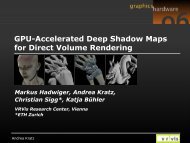
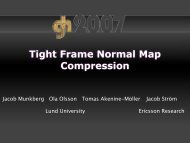



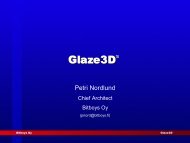
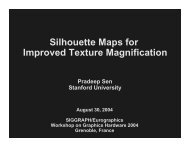
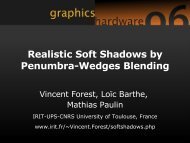
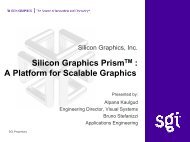
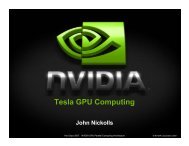

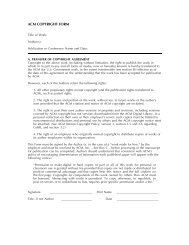
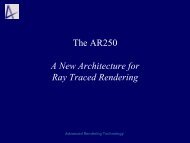
![Evaluation Form [18 KB-pdf] - Graphics Hardware](https://img.yumpu.com/39855234/1/190x245/evaluation-form-18-kb-pdf-graphics-hardware.jpg?quality=85)